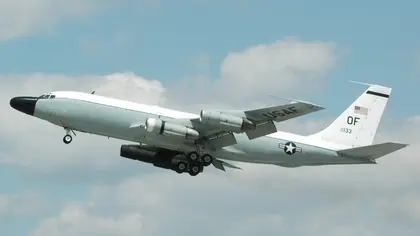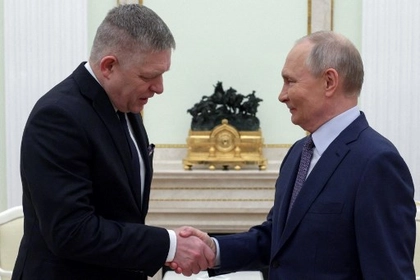A NATO electronic warfare jet flew for hours above Moldova during the recent Second European Political Community Summit, in the Atlantic Alliance’s first acknowledged air reconnaissance mission over the former Soviet republic, news reports Friday said.
Civilian air traffic tracking sites showed that on June 1 in mid-afternoon a British Royal Air Force RC-135 jet was flying tracking patterns above central to southern Moldova.
- See the most recently published Ukraine news reports from today.
- Russian Losses
JOIN US ON TELEGRAM
Follow our coverage of the war on the @Kyivpost_official.
The Boeing RC-135 Rivet Joint is a surveillance aircraft equipped with a radar suite and other sensors reportedly capable of identifying ground and air targets with pinpoint accuracy at ranges in the hundreds of kilometers. NATO air forces employ the high-tech plane to “vacuum up” an antagonist’s electronic transmissions and convert the data into targeting information.
Crammed with communications intercept gear, code-cracking computers and onboard linguists, the plane also functions as a flying eavesdropping platform capable of intercepting and deciphering most phone conversations and digital data transmitted anywhere the aircraft’s sensors are looking.
Since Russia’s invasion of Ukraine in February 2022, NATO air forces have deployed RC-135s and other surveillance aircraft almost daily to fly reconnaissance missions along Romania and Poland’s eastern borders, monitoring the war – particularly locations of Russian combat vehicles, aircraft and air defense systems. According to Ukrainian officials some of the sensitive data collected in the spy flights is turned over to the Ukrainian military – although sometimes not quickly enough.

How I Helped NATO Destroy Ukraine’s Weapons
The Thursday Royal Air Force mission over Moldova, some 100 kilometers east from flight paths in the past, extended the reach of NATO data collection capacity deeper into Ukraine’s partially occupied Kherson and Zaporizhzhia regions: areas widely reported to be probable sectors for a major Kyiv counterattack against Russian forces in the near future.
The military news website The War Zone identified air traffic watcher Hans Kristensen as the first plane watcher to spot the British overflight.
Officially, the Royal Air Force mission to Moldova was defensive and part of security measures put in place by NATO from May 31 to June 2 to protect 45 heads of states and governments, as well as leaders of European Union institutions, attending the European Political Community at a castle near the Moldovan capital Chisinau.
But the summit concentrated, arguably, not just sufficient planes for prudent security, but more NATO reconnaissance aircraft into a tight air space than any time since the Balkan Wars in the 1990s. Civilian flight tracking radars on Thursday observed a second RC-135, flown by the US Air Force over neighboring Romania, flying a parallel pattern to the Royal Air Force spy jet and a US Air Force AWACS (call sign Nato03) air combat control jet flying a circle pattern over Romania’s Danube delta region adjacent to Romania.
Other military aircraft possibly in the air in support of the summit included a Slovakian Gripen fighter jet operating in that country’s eastern air space, and an unidentified military aircraft flying along the Romania-Moldova border, according to civilian air traffic radar data.
France’s Defense Ministry on Thursday published images of Mirage 2000 fighter jets and ground-based anti-aircraft missile teams deployed “to Chisinau” on June 1 as part of protection measures for dignitaries attending the summit, including French President Emmanuel Macron.
Ukrainian President Volodymyr Zelensky was a high profile speaker at the event. Kremlin officials have repeatedly called on the Russian military to assassinate Zelensky if possible. Former Russian President Dmitry Medvedev on May 4 said: “There are no options left but the physical elimination of Zelensky and his clique.”
A neutral state, Moldova currently has neither flying combat jets nor effective means of protecting its air space. Moldova’s senior leadership headed by President Maia Sandu has for the most part expressed support for Ukraine in its war against Russia but held back from an outright Moldovan attempt to try and join NATO, for fears of spiking tensions in the Transnistria region and antagonizing Russia.
A sliver of Moldovan territory heavily settled by ethnic Slavs, the Transnistria region has been de facto independent from Chisinau since the early 1990s, following Kremlin military intervention in support of “Transnistrian separatists.”
Called “peacekeepers” in Russian state-controlled media, an on-paper 1,500-member Transnistria infantry brigade remains deployed to the region. According to Ukrainian military observers, the force is poorly trained and unlikely to be capable of serious combat. It is almost totally isolated from Russian mainland support.
In 2016, Moscow promised to send the Transnistria brigade back to Russia but reneged on the commitment. On March 15, 2022, the Parliamentary Assembly of the Council of Europe declared Transnistria illegally occupied by Russia.
Kremlin critic Igor Girkin, a former Russian military intelligence operative active in Russia’s 1991-92 takeover of Transnistria and the 2014 invasion of Ukraine’s Donbas region, in a Friday editorial on Russian troops in Transnistria wrote: “They are completely cut off… we can’t do anything to help them.”
Asked by reporters in Chisinau about Ukraine’s stance on Transnistria and the Russian “peacekeepers” still present in the territory, Zelensky said Ukrainian military action against the Russian troops there would be impossible without Moldova’s consent. Russian troop presence in Transnistria is illegal and “if they want to live” they should go back to Russia, he added.
You can also highlight the text and press Ctrl + Enter






